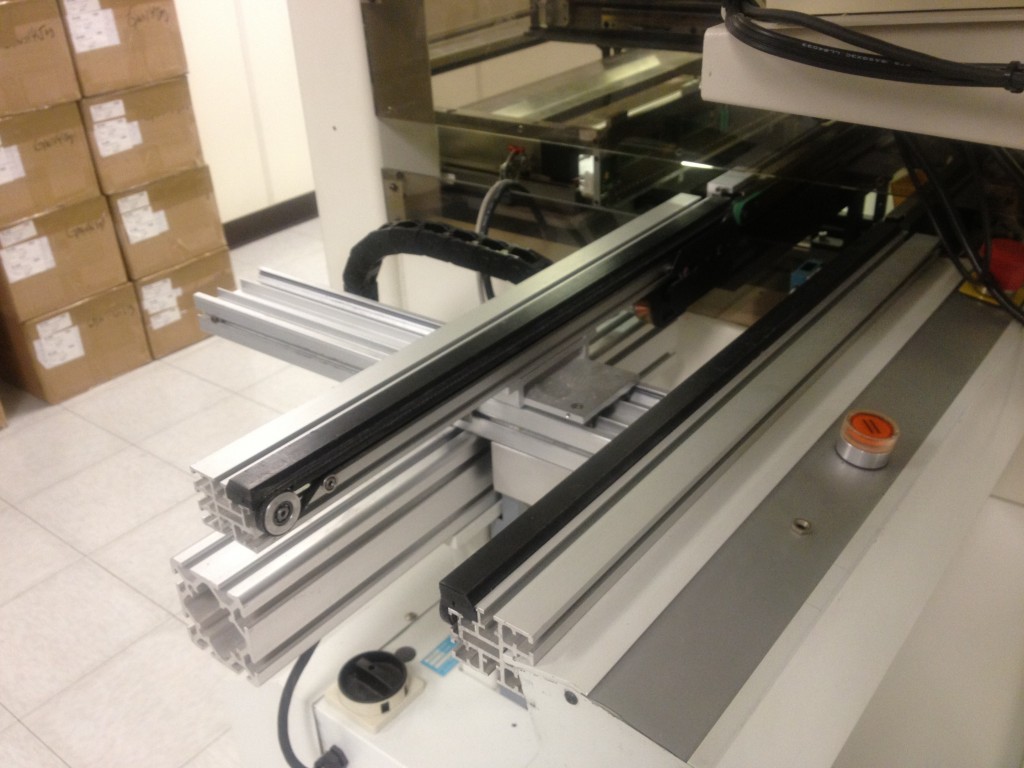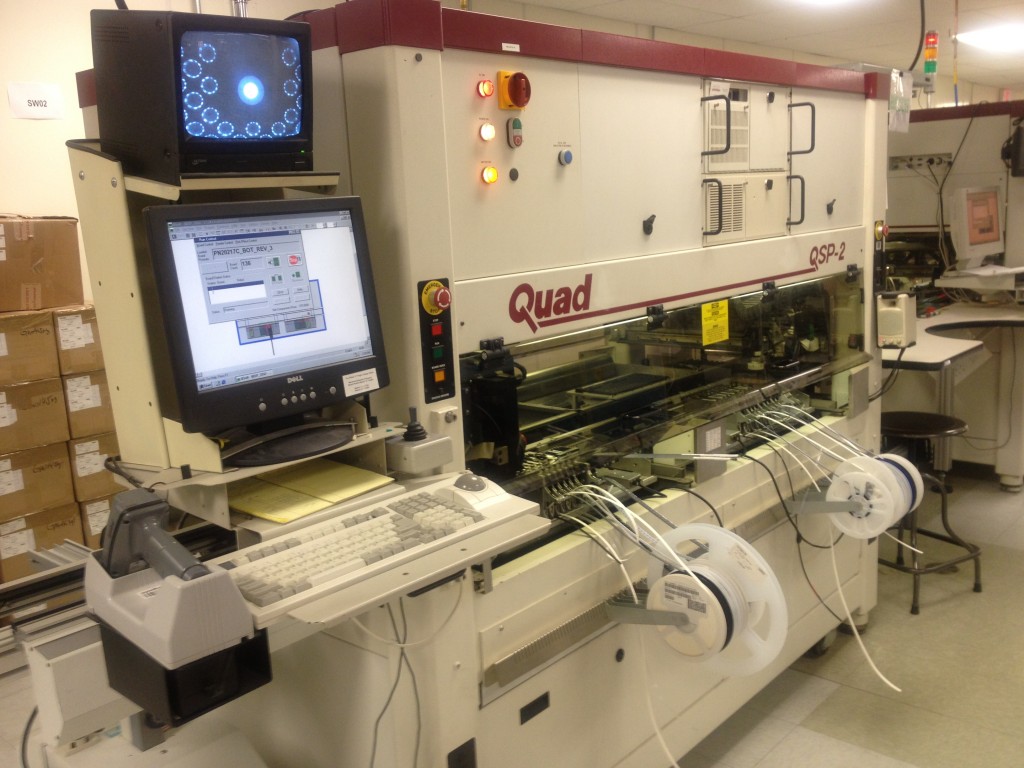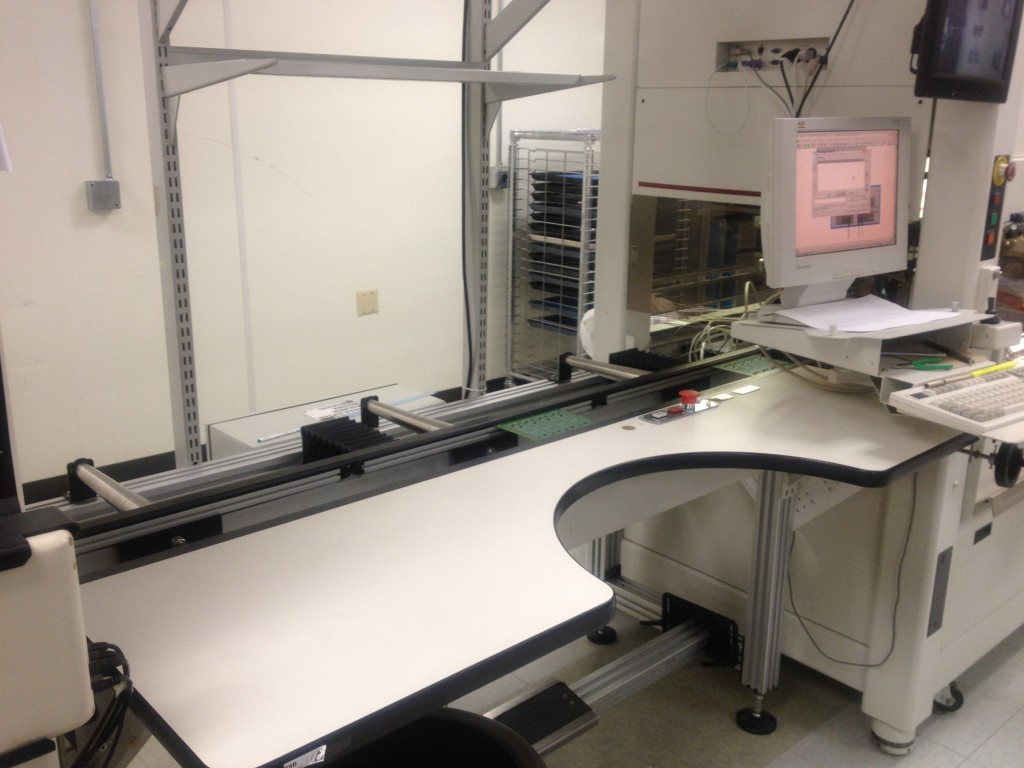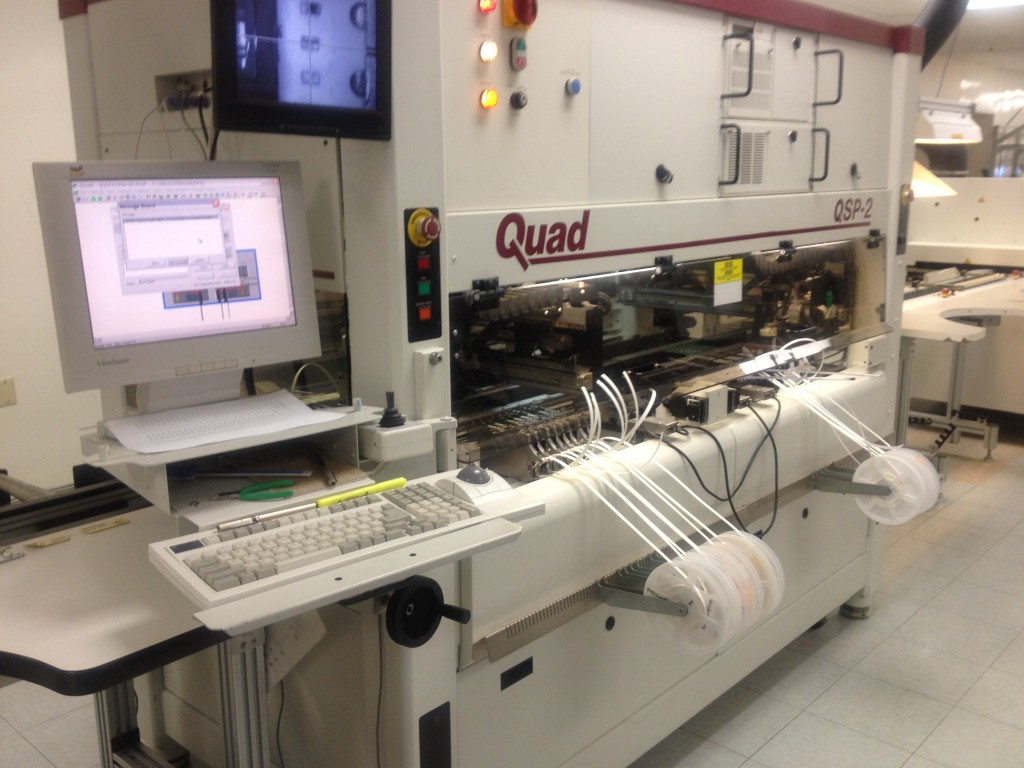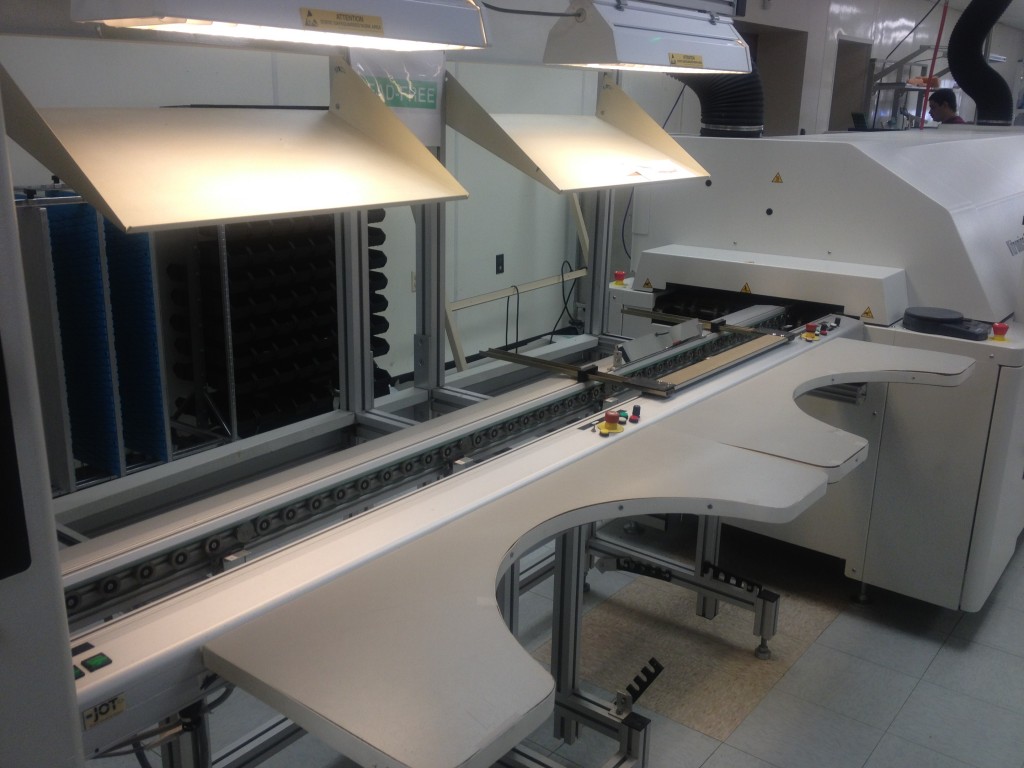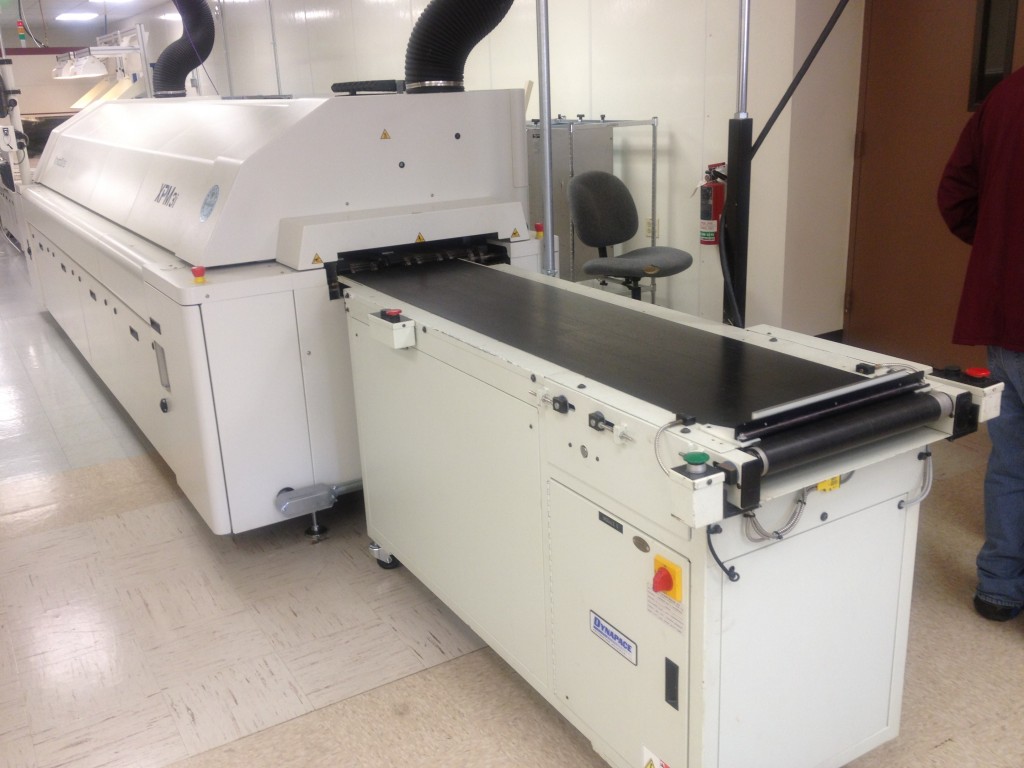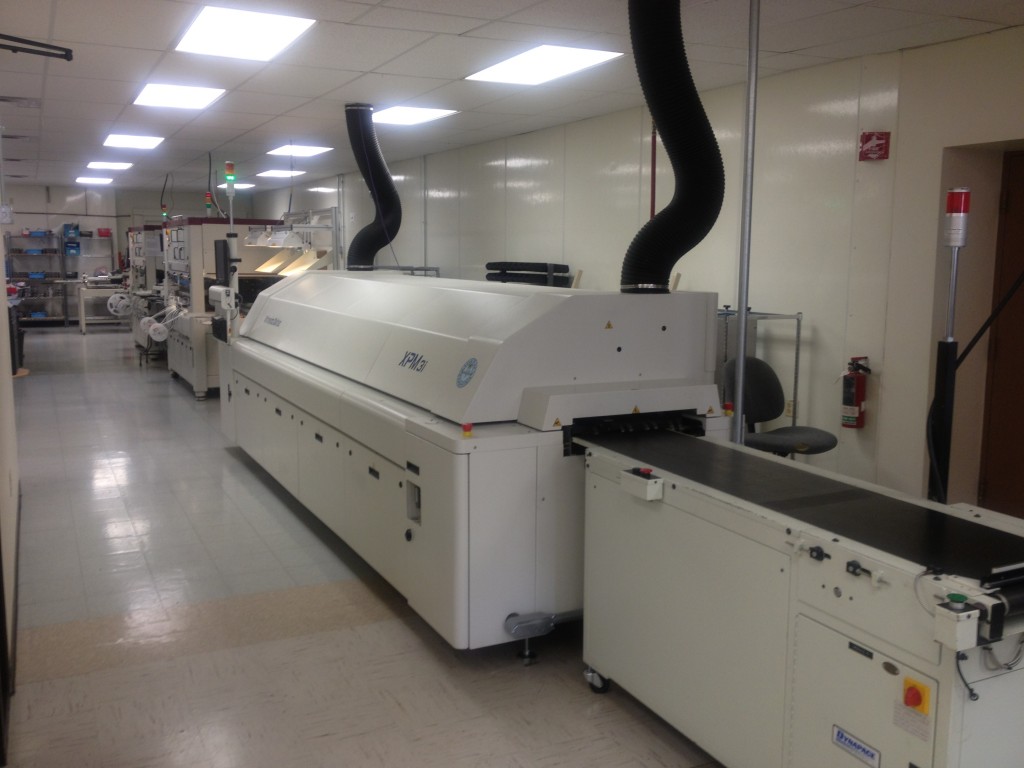When Worthington Assembly started assembling circuit boards 30+ years ago, the smallest component was an 1/8th watt thru-hole resistor. Surface mount parts were just being invented somewhere in an IBM research lab in upstate New York. Fast forward a few decades and Worthington Assembly finds itself with two high speed pick and place machines that are placing components as small as the sand on the beach. The biggest focus we had a couple years ago was just making sure these machines ran properly and good product came out. Material handling was hardly an issue when you were processing boards once every eight minutes. But times change, and businesses change. Worthington Assembly certainly did. We went from processing a few hundred boards per week, at most, to a few hundred boards per day, regularly. So material handling became a great issue. Especially when your pick and place machine decides it doesn't feel like paying attention to the light sensor that tells the conveyor to stop. Nah, just let that board fall on the floor. (Editor's Note: Don't worry. We never ship something like that. We just had to deal with it)
We started simple. We simply put a conveyor on each end of our most used pick and place machine. It made it simple for the operator to place a circuit board on the in feed conveyor and simply pickup the circuit board from the out feed conveyor. This worked, for the most part. But at the end of the day it was still a very manual process. After looking around for a while we found a couple more conveyors that could really make this work. Or so we thought.
So one day we decide "Ok, we have all of the equipment we need. Let's put all of these machines in one nice assembly line." So here we are with pallet jacks, wrenches, hammers, 2x4's, the whole nine yards, moving and shuffling everything around. We placed our first pick and place machine where we wanted it and then put a conveyor on either end of it. Then we placed our second pick and place machine behind the in feed conveyor of our first pick and place machine. Only one problem. This sucker is heavy. I mean thousands of pounds heavy. And since it wasn't sitting quite straight, we had to wedge this machine in place. It literally took hours but we got it where we needed it. We just slapped on its own in feed conveyor and then gave it a shot. This is where the "Or so we thought" comes into the picture. Our pick and place machines were wired wrong. Their SMEMA cables (SMEMA is the communication standard for all circuit board assembly lines) had been manually changed by a previous owner. After much time and effort we finally figured out what was wrong and switched the wiring back to standard SMEMA wiring. All's well right? Wrong.
Turns out one of the conveyors were purchased second hand, was not working. At all. It would turn on and you could see that it had power, but none of the motors would ever spin. We looked at the PLC and saw that it had a "fault" LED lit up. After some web searches we found this is a common problem for this specific PLC. We decided that must be the problem so we went ahead and ordered a new one. We peeled the program off of the old PLC and tried loading it on the new one. Same problem. Nothing happening. At this point we decided to contact tech support for this conveyor manufacturer, who happens to be Simplimatic.
We here at Worthington Assembly cannot say enough good things about these guys. They absolutely went out of their way to help us out. They went above and beyond to find all of the drawings they could and all of the software that was originally loaded on the PLC. Keep in mind this is a completely discontinued machine that we bought second hand. Simplimatic never received or even asked for a dime from us. Ultimately, we still weren't getting far though. But it wasn't Simplimatic's fault. We simply could not understand what the problem was.
Then one day a guy walks in our building, looking for extra work. He tells us that he works for a guy who designs control systems. You would hire this guy if you were a sewer plant and you needed somebody to develop a system to help you control all of the valves and heaters and motors that made your plant work. This is some pretty complicated stuff. All we needed was somebody to make a couple motors start spinning on a conveyor. So we asked him to give us a quote, half expecting never to hear from him again.
Then one day we get an email. His guy is interested. Even better, he's just looking for a lunch. He appreciates a small local manufacturing company and wants us to keep him in mind for any future projects that we might be able to use his help on. So we have him in and after a few minutes, he's got this thing working perfectly. Turns out he did exactly what Simplimatic had been trying to tell me the whole time. "Have you tried to just change the fault code from 1 to 0?" Sure enough, that's all it took. Finally our SMT line was complete.
Today, we have a fully functional reliable SMT assembly line. You can view the video below or I can try my best to paint a word picture for you. First you have the printing process. This is where we apply the solder paste to the bare circuit board. From there you place the circuit board on the first SMT conveyor.
This is a small 18" long conveyor that holds the board until the pick and place machine is ready for it. Once it is, the conveyor will feed the board into the machine, so the operator can then place the next circuit board on the conveyor and wait until the machine finishes the one it has and asks for the next one.
The first pick and place machine only assembles half of the circuit board. From there he spits it out onto a 3 zone inspection conveyor.
This conveyor has a small cutout where and operator can get in close to see the circuit board and make sure there are no issues with it. The conveyor has 3 zones which allows it to hold 3 circuit boards while it waits for the second pick and place machine to ask for one. This gives our assembly line elasticity. As one machine might be faster than the other, it will queue up boards for the next one. But sometimes the next pick and place machine ends up being faster because the first pick and place machine has exhausted a part and needs to have it replaced. This means the second pick and place machine can continue to run, using the 3 boards that are queued up for it.
So once the second pick and place machine finishes the second half of the circuit board, it goes onto a third conveyor that has 5 zones and two inspection stations.
The first inspection station is often used to place larger or odd shaped components by hand. From there the operator will press a small button that sends the board to the next inspection station where somebody can look at each placement before pressing another small button to send it into the reflow oven. After the reflow oven we have a large, wide, flat belt conveyor. This conveyor looks a lot like the conveyor they use at your local grocery store.
Boards drop gracefully at a small angle onto this conveyor and travel about 48", allowing sufficient time for the operator to now grab the completed board and put it into the AOI to continue our process.
This all makes perfect sense right? Well you would be surprised at how few contract manufacturers do this. Most of them are doing exactly what we were 12 months ago. Carry each board by hand from machine to machine. Not only is this time consuming but it's also dangerous. Boards can be dropped, and they often are. Now even if a manufacturer happens to get his pick and place line running well, they often miss what we consider the most crucial step. That of catching the board from the reflow oven. For whatever reason most people rely on an operator standing at the end of the oven to catch each individual circuit board. Talk about time consuming. Not to mention dangerous. What if that operator gets distracted or forgets he's supposed to be there. I cannot tell you how many times I've visited manufacturers and have witnessed this happened. I've literally seen dozens of circuit boards land on the floor, only to be picked up by a worker and placed into a rack, hoping nobody noticed. It sickens me. Worthington Assembly is determined to be better than that. We are a detail oriented company and we are not going to let things like that fly here.
Worthington Assembly's SMT line is now complete. And we are prepared for a much greater volume of assemblies than we ever have been in the past. So if you've ever talked to us before about your assembly and we simply could not afford to build it at the price you were hoping for, talk to us again. We're a very different company in 2012 than we even were in 2011.

